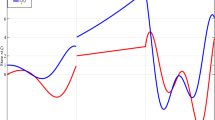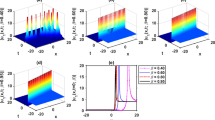Abstract
From the current scenario it is well known that the most of the engineering problem leads to the mathematical model with different concept. Associated with these phenomena, the present investigation gathers some physical interpretation of different model that leads to couple nonlinear time fractional differential equation encompass with variable order within certain domain relating to the physical significance of the corresponding problem. The system of equations is based upon Caputo-type fractional differential equation in particular cases. The crux of this investigation is that the use of various solution approach for the modeled problems such as “Reduced Differential Transform Method” and “Adomian Decomposition Method”. Finally, the aforesaid methodologies are also applicable for the infectious diseases model and verified in particular case of integral order with an earlier investigation.


















Similar content being viewed by others

Availability of Data and Material
No data is used.
Code Availability
Not applicable.
Abbreviations
- \(s(t)\) :
-
The number of uninfected and no immunity computers that are susceptible at any given time t
- \(a(t)\) :
-
At any given time t, new or ancient antidotal computers in use
- \(e(t)\) :
-
The number of exposed computers that are susceptible to infection at any given time t
- \(i(t)\) :
-
The number of infected computers that must be cured at any given time t
- \(q(t)\) :
-
At any given time t, infected computers quarantined
- \(r(t)\) :
-
At a time t, uninfected computers with temporary immunity
- \(B\) :
-
Rate at which the new computers associated to network system i.e. Birth rate
- \(\mu\) :
-
Rate of death when computers are affected other than virus attack
- \(k_{1}\) :
-
Rate of death when computers are affected by virus attack
- \(\beta\) :
-
Transmission rate when susceptible computers contact with infected ones
- \(\alpha\) :
-
The rate at which antidotal process begins with the susceptible computers
- \(\phi_{1}\) :
-
Rate of virus attack
- \(\phi_{2}\) :
-
Rate of recovery by antidotal computers
- \(\gamma\) :
-
Rate of coefficient of exposed class (E to I)
- \(\sigma_{1}\) :
-
Infectious class (I to R)
- \(\sigma_{2}\) :
-
Infectious class (I to Q)
- \(\delta\) :
-
Quarantine class (Q to R) and its rate
- \(\eta\) :
-
Recovery class (R to S) and its rate
References
Samko, S.G., Ross, B.: Integration and differentiation to a variable fractional order. Integr. Transf. Spec. Funct. 1(4), 277–300 (1993)
Lorenzo, C.F., Hartley, T.T.: Variable order and distributed order fractional operators. Nonlinear Dyn. 29, 57–98 (2002)
Coimbra, C.: Mechanics with variable-order differential operators. Ann. Phys. 12, 692–703 (2003)
Chechkin, A.V., Gorenflo, R., Sokolov, I.M.: Fractional diffusion in inhomogeneous media. J. Phys. A: Math. Gen. 38, L–679 (2005)
Sun, H., Chen, W., Chen, Y.: Variable-order fractional differential operators in anomalous diffusion modelling. Physica A 388, 4586–4592 (2009)
Hosseinzadehi, Kh., Mardani, M.R., Salehi, S., Paikar, M., Waqas, M., Ganji, D.D.: Entropy generation of three-dimensional Bödewadt flow of water and hexanol base fluid suspended by Fe3O4 and MoS2 hybrid nanoparticles. J. Phys. 95, 57 (2021)
Hosseinzadehi, Kh., Roghani, So., Mogharrebi, A.R., Asadi, A., Waqas, M., Ganji, D.D.: Investigation of cross-fluid flow containing motile gyrotactic microorganisms and nanoparticles over a three-dimensional cylinder. Alex. Eng. J. 3297–3307 (2020)
Hosseinzadehi, Kh., Salehi, S., Mardani, M.R., Mahmoudi, F.Y., Waqas, M., Ganji, D.D.: Investigation of nano-Bioconvective fluid motile microorganism and nanoparticle flow by considering MHD and thermal radiation. Inform. Med. Unclocked 21, 100462 (2020)
Hosseinzadehi, Kh., Roghani, So., Asadi, A., Ganji, D.D.: Optimization of hybrid nanoparticles with mixture fluid flow in an octagonal porous medium by effect of radiation and magnetic field. J. Therm. Anal. Calorim.y 143, 1413–1424 (2021)
Hosseinzadehi, Kh., Asadi, A., Mogharrebi, A.R., Azari, M.E., Ganji, D.D.: Investigation of mixture fluid suspended by hybrid nanoparticles over vertical cylinder by considering shape factor effect. J. Therm. Anal. Calorim. 143, 1081–1095 (2021)
Salehi, S., Nori, A., Hosseinzadehi, Kh., Ganji, D.D.: Hydrothermal analysis of MHD squeezing mixture fluid suspended by hybrid nanoparticle between two parallel plates. Case Stud. Therm. Eng. 21, 100650 (2020)
Gholinia, M., Hosseinzadehi, Kh., Ganji, D.D.: Investigation of different base fluids suspend by CNTs hybrid nanoparticle over a vertical circular cylinder with sinusoidal radius. Case Stud. Therm. Eng. 21, 100666 (2020)
Keskin, Y., Oturanc, G.: Reduced differential transform method: a new approach to factional partial differential equations. Nonlinear Sci. Lett. A 1, 61–72 (2010)
Singh, B.K., Kumar, P.: FRDTM for numerical simulation of multi-dimensional, time-fractional model of Navier–Stokes equation. Ain Shams Eng. J. (2016).
Srivastava, V.K., Mishra, N., Kumar, S., Singh, B.K., Awasthi, M.K.: Reduced differential transform method for solving (1 + n)-Dimensional Burgers’ equation. Egypt. J. Basic Appl. Sci. 1, 115–119 (2014)
Saravanan, A., Magesh, N.: A comparison between the reduced differential transform method and the Adomian decomposition method for the Newell–Whitehead–Segel equation. J. Egypt. Math. Soc. 2, 259–265 (2013)
Saravanan, A., Magesh, N.: An efficient computational technique for solving the Fokker–Planck equation with space and time fractional derivatives. J. King Saud Univ. Sci. 28, 160–166 (2016)
Feng, X.: Exact wave front solutions to two generalized coupled nonlinear physical equations. Phys. Lett. A 213, 167–176 (1996)
Arora, G., Singh, B.K.: Numerical solution of Burgers’ equation with modified cubic B-spline differential quadrature method. Appl. Math. Comput. 224, 166–177 (2013)
Singh, B.K., Kumar, P.: A novel approach for numerical computation of Burgers’ equation (1 + 1) and (2 + 1) dimension. Alex. Eng. J. 55, 331 (2016)
Jafari, H., Daftardar-Gejji, V.: Solving a system of nonlinear fractional differential equations using Adomian decomposition. J. Comput. Appl. Math. 196, 644–651 (2006)
Chen, Y., An, H.L.: Numerical solutions of coupled Burgers equations with time- and space-fractional derivatives. Appl. Math. Comput. 200, 87–95 (2008)
Abdou, M.A.: Fractional reduced differential transform method and its applications. Int. J. Nonlinear Sci. 26, 55–64 (2018)
Chakraborty, A.K., Shahrear, P., Islam, Md.A.: Analysis of Epidemic model by differential transform method. J. Mult. Eng. Sci. Tech. 2458–9403 (2017)
Abdou, M.A., Elhanbaly, A.: Decomposition method for solving a system of coupled fractional-time nonlinear equations. Phys. Scr. 73, 338–348 (2006)
Turkyilmazoglu, M.: Parametrized adomian decomposition method with optimum convergence. ACM Trans. Model. Comput. Simul. 27, 4 (2017)
Turkyilmazoglu, M.: Equivalence of ratio and residual approaches in the homotopy analysis method and some applications in nonlinear science and engineering 120, 63–81 (2019)
Turkyilmazoglu, M.: Accelerating the convergence of Adomian decomposition method. J. Comp. Sci. 31, 54–59 (2019)
Noori, S.R.M., Taghizadeh, N.: Study of convergence of RDTM for different classes of differential equations. Int. J. Differ. Eq. (2021).
Li, X.P., Wang, Y., Khan, M.A., Alshahrani, M.Y., Muhammad, T.: A Dynamical study of SARS-COV-2: a study of third wave. Results Phys. 29, 104705 (2021)
Li, X.P., Gul, N., Khan, M.A., Bilal, R., Ali, A., Alshahrani, M.Y., Muhammad, T., Islam, S.: A new Hepatitis B model in light of asymptomatic carriers and vaccination study through Atangana–Baleanu derivative. Results Phys. 29, 104603 (2021)
Assi, M.D., Safi, M.A., Khan, M.A., Beigi, A., Aly, A.A., Alshahrani, M.Y.: A mathematical model for SARS-COV-2 in variable-order fractional derivative. Eur. Phys. J. Spec. Top. (2020)
Naik, P.A., Owolabi, K.M., Zu, J., Naik, M.: Modeling the transmission Dynamics of COVID-19 pandemic in Caputo-type fractional derivative. J. Multiscale Model. 12 (2021).
Naik, P.A., Zu, J., Owolabi, K.M.: Global dynamics of a fractional order model for the transmission of HIV epidemic with optimal control. Chaos Solitons Fractals 138, 109826 (2020)
Mishra, A.M., Purohit, S.D., Owolabi, K.M., Sharma, Y.D.: A nonlinear epidemiological model considering asymptotic and quarantine classes for SARS COV-2 virus. Chaos Solitons Fractals 138, 109953 (2020)
Naik, P.A., Zu, J., Owolabi, K.M.: Modeling the mechanics of viral kinetics under immune control during primary infection of HIV-1 with treatment in fractional order. Physica A: Stati. Mech. Appl. 545, 123816 (2021)
Owolabi, K.M., Shikongo, A.: Fractal- fractional operator method on HER2+ Breast Cancer dynamics. Int. J. Appl. Comput. Math. 7, 85 (2021)
Naik, P.A., Owolabi, K.M., Yavzu, M., Zu, J.: Chaoticdynamics of a fractional order HIV-1 model involving AIDS- related cancer cells. Chaos Solitons Fractals 140, 110272 (2020)
Owolabi, K.M., Pindza, E., Atangana, A.: Analysis and pattern formation scenarios in the super diffusive system of predation described with caputo operator. Chaos Solitons Fractals 152, 11468 (2021)
Owolabi, K.M., Atangana, A., Gomez-Aguilar, J.F.: Fractional Adams-Bashforth scheme with the Liouville-Caputo derivative and application to chaotic systems. Am. Inst. Math. Sci. 14, 2455–2469 (2021)
Karaagac, B., Owolabi, K.M., Nisar, K.S.: Analysis and Dynamics of illicit drug use described by fractional derivative with Mittag-Leffler kernel. Comput. Mater. Continua 65, 1905–1924 (2020)
Funding
Not applicable.
Author information
Authors and Affiliations
Contributions
All the authors have equally contributed to complete the manuscript, i.e. SNM has completed the introduction section and checked the similarity with grammar, PJ has formulated the problem, simulated the semi-analytical results and completed the draft, SRM has corrected the results and completed the discussion section.
Corresponding author
Ethics declarations
Conflict of interest
There is no conflict of interest to publish our paper in your esteemed journal.
Consent to Participate
Not applicable.
Consent for Publication
All the authors have given their consent to publish the paper.
Ethics Approval
The entire work is original work of the authors.
Additional information
Publisher's Note
Springer Nature remains neutral with regard to jurisdictional claims in published maps and institutional affiliations.
Rights and permissions
About this article
Cite this article
Mohapatra, S.N., Mishra, S.R. & Jena, P. Time-Fractional Differential Equations with Variable Order using RDTM and ADM: Application to Infectious-Disease Model. Int. J. Appl. Comput. Math 8, 138 (2022). https://doi.org/10.1007/s40819-022-01332-2
Accepted:
Published:
DOI: https://doi.org/10.1007/s40819-022-01332-2



